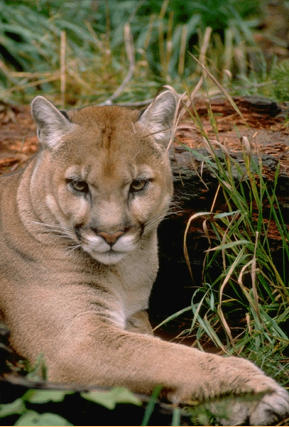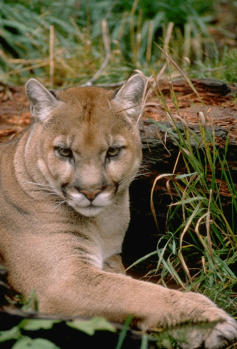



© 2014-2021 Copyright by P. K. H. Groth, Denver, Colorado, USA All rights reserved - See contact page for for permission to republish article
excerpts.
Mountain Lion Danger and Reaction Advice
Mountain
lions
are
propagating
in
Colorado
and
are
becoming
a
nuisance
and
danger
to
game.
Colorado
Parks
and
Wildlife
decided
in
2017
to
cull
lions
and
bears in western Colorado because they are excessively predating game.
That
also
changes
things
and
begs
caution
for
hunter
safety.
Lions
have
rarely
been
seen
in
the
past
because
they
are
solitary,
elusive
animals,
which
normally
avoid
humans.
Their
increased
numbers
statistically
raise
the
possibility
that
unaware
hunters
may
bump
into
and
be
annoyed
by
cougars.
That
is
why
I
include
the
following
warnings
from
New
Mexico
Parks
and
Wildlife and the US Forest service [ I added some extensions].
Basic Knowledge:
1.
Attacks
are
extremely
rare
[commonly
when
humans
unknowingly
mimic cougar prey]
2.
Cougars
are
most
active
at
dusk
and
dawn.
Avoid
recreating
in
non-open
areas
during
those
hours.
[Hunters
beware
when
traveling
to
and
from
stands, or approaching your kill site.]
3.
Running
and
unleashed
dogs
can
trigger
an
attack.
[Cats
become
incited
to
kill, and they like chasing easy prey].
4.
People
traveling
alone
are
more
vulnerable
than
groups.
[Most
single
people
normally
do
not
talk
to
themselves,
and
they
make
less
movement
noise, and they are more liable to surprise a lion.]
What to Do if You Encounter a Cougar:
A. Face a cougar and slowly back away if you see a lion.
B. NEVER run or play dead. [Running incites the lions kill instinct].
C.
Immediately
pick
up
small
children
and
calm
them.
[Screaming
and
their
physical
agitation
may
evoke
a
cougar’s aggression instinct.]
D.
Look
for
and
leave
room
for
a
cougar
to
escape.
[A
cornered
cat
evokes
survival
reaction.
NEVER
approach
a
cat,
which is an indication of challenge.]
E. Make noise, lift up your arms to make yourself look larger, and shout loudly.
F.
If
a
cougar
attacks,
violently
fight
back
with
sticks,
stones,
backpacks
or
whatever
else
is
at
hand.
[Do
not
allow
the lion to get to your rear, a favorite-by-instinct attack and kill position for cats.]
Be Alert!
Do not approach dead animals – cougars linger near and defend their prey. [If your kill has been pillaged, and
moved and covered with debris, it may have been claimed by a cougar, which commonly linger by the meat
for several days. Bears do not generally cover game meat, but may move it.]
Hike in groups, make enough noise to alert cougars, and avoid surprise encounters.
Carry a stout walking stick and bear pepper spray if lions are active in the area.
Keep pets leashed
NEVER allow children to run ahead or fall behind. [Children should always WALK, not run. A child running
incites cougar curiosity and an instinctive cougar reaction to chase.]
[Report overly curious lions to authorities. The lion may be more aggressive and dangerous because of old
age, illness, poor teeth or wounds.]
Cougar tracks may appear like dog tracks to most people. Below is a New Mexico Department of Wildlife - US
Forest Service comparison.
Lion Addenda:
1. Look at lions, but do not stare fixated at a
cougar. This is body language for asking for a
confrontation, just as it would be with two
humans in an argument intensely staring at each
other. A provoked big cat is faster runner than
you will ever be.
Do you have a house cat? Be a naughty boy as I
used to be. Find your cat when it is resting and
intensely stare at it without moving. Even though
house cats have been domesticated thousands of
years, it will probably revert to defensive instinct, get nervous and move away - or get ornery.
2. Loggers in India rain forests concentrate during their wandering to select and fell trees. This leaves them
vulnerable to attacks by resident tigers. Authorities recruited an animal scientist to help stop the attacks. He
created bright yellow shirts with large eyes painted on the back. The shirt eyes slightly shifting as loggers moved
which fooled the tigers. The attacks greatly reduced. Prey cats instinctively want to attack advantageously – which
means silently from the victim’s rear.
3. Never run from lions! An unfortunate track runner athlete took a recess run around an Idaho Springs, Colorado
mountain trial behind the high school. He was attacked from the back by a lion and killed. I am reminded (and
caution myself) of the incident every time I drive by the memorial bridge erected in his memory.
4. Parents, heed the warning! NEVER ever let children linger behind a group while hiking in lion territory! A six-year-
old Colorado boy completely disappeared (never found) when he lagged behind the hiking family. The conclusion
was that a mountain lion killed and dragged the boy to its den.
5. Lions are reclusive animals. They often live near unknowing humans. Some of our west Denver neighbors have
been surprised to see bold lions within our development. One had a lion consuming a deer under their deck,
returning three days to the kill site. Golden, Colorado is a valley. The hunting restrictions increase deer populations,
which in turn attracts big cats. The surrounding hills are prime lion hunting ground. So, just because you do not see
cougars does not mean they are not there.
Throttling
a
Mountain
Lion:
In
July
a
lone
trail
runner
encountered
an
immature
but
still
formidable
mountain
lion
while
jogging
in
a
State
Park
in
the
foot
hills
west
of
Ft.
Collins,
CO.
He
knew
how
to
correctly
interact
with
the
lion,
but
the
curious
juvenile
was
instinctively
following
steps
to
secure
a
meal.
The
hiker
managed
to
get
his
hands
around
the
inbound
lion
and
strangle
it.
That
was
one
prepared,
cool-headed
and
lucky
bloke.
Park’s
spokeswoman
commented
the
hero
“will
not
have
to
buy
another
beer
in
his
life.”
Become
educated
about
all
facets of the wild!
Never
run
from
an
encountered
mountain
lion.
Never!
Lions
specialize
in
running
down
prey
(or
what
acts
like
prey).
West
of
the
I-70
tunnel
near
Idaho
Springs
is
a
bridge
dedicated
to
Scott.
His
sport
was
track,
and
he
practiced
running
hill
trails
behind
the
high
school.
His
body
was
found,
partially
eaten
and
dragged
off
to
a
lion
cache.
Elsewhere,
a
seven
year
old
boy
lingered
far
behind
a
hiking
family.
He
too
was
killed
–
for
being
in
the
rear.
Cougars Observations:
Cougars
can
run
45
mph,
leap
30
horizontal
feet
from
a
standstill,
jump
20
feet
up
a
cliff
and
easily clear most fences without thinking.
Lions
place
their
rear
paws
into
their
front
paw
print
when
leisurely
walking.
A
single
set
of
tracks is commonly a male, while two or more tracks indicate a female and kittens.
Colorado
mountain
lions’
males
are
larger
than
females,
weighing
an
average
150
pounds.
Females
weigh
about
90
pounds.
Males
make
a
scrape
of
leaves,
twigs
and
urine.
As
if
symbolically,
in
rocky
terrain
where
there
is
no
loose
vegetation
to
cover
a
kill,
it
will
seek
a
single
stick
to
place
on
the
kill.
Lions
have
a
large
territory.
Female
lions
in
estrus
may
walk
back and forth caterwauling to attract males.
Author
Maurice
Hornaker
describes
lion
kills.
He
claims
that
seeing
a
lion
break
an
elk
neck
as
one
of
the
greatest
feats
in
the
world.
The
charge
and
mount
is
extremely
quick,
claws
embed
in
the
shoulders
and
with
muscular
reflex
claws
reach
forward
to
pull
back
and
snap
the
elk’s
neck, Hornicker believes lions take down more elk bulls than cows.
There are over 40 names for mountain lions.
Mountain lion avoidance advice is on
www.mountainlion.org
Learn more about lions at www. wildlifeimages.org. and Colorado parks and Wildlife
Cat
and
even
mountain
lions
can
develop
a
nervous
condition
called
vuroceoe.
It
causes
the
feline to nonsensically eat sticks, and often results in the animal’s death.












- Hunter welfare
- Hunter poster child
- Altitude sickness
- Hunter heart attacks
- Hunter heart stress
- Altitude sleep problems
- Hunter spine/bone damage
- Back country hazards
- Man made hazards
- Hunter bear attacks
- Bear problems
- Mtn lion Awareness
- Insect problems and diseases
- Hunt camp rodent problems
- Game meat dangers
- Elk meat diseases




© 2016 -2021 Copyright by P. K. H. Groth, Denver, Colorado, USA All rights reserved -
See contact page for for permission to republish article excerpts.
Mountain
lions
are
propagating
in
Colorado
and
are
becoming
a
nuisance
and
danger
to
game.
Colorado
Parks
and
Wildlife
decided
in
2017
to
cull
lions
and
bears
in
western
Colorado
because
they
are
excessively
predating game.
That
also
changes
things
and
begs
caution
for
hunter
safety.
Lions
have
rarely
been
seen
in
the
past
because
they
are
solitary,
elusive
animals,
which
normally
avoid
humans.
Their
increased
numbers
statistically
raise
the
possibility
that
unaware
hunters
may
bump
into
and
be
annoyed
by
cougars.
That
is
why
I
include
the
following
warnings
from
New
Mexico
Parks
and
Wildlife
and
the
US
Forest service [ I added some extensions].
Basic Knowledge:
1.
Attacks
are
extremely
rare
[commonly
when
humans
unknowingly mimic cougar prey]
2.
Cougars
are
most
active
at
dusk
and
dawn.
Avoid
recreating
then.
[Hunters
beware
when
traveling
to
and
from stands, or approaching your kill site.]
3.
Running
and
unleashed
dogs
can
trigger
an
attack.
[Cats
become incited to kill, and they like chasing easy prey].
4.
People
traveling
alone
are
more
vulnerable
than
groups.
[Single
people
normally
do
not
talk
to
themselves,
make
less movement noise and are more liable to surprise a lion.]
What to Do if You Encounter a Cougar:
A. Face a cougar and slowly back away if you see a lion.
B.
NEVER
run
or
play
dead.
[Running
incites
the
lions
kill
instinct].
C.
Immediately
pick
up
small
children
and
calm
them.
[Screaming
and
their
physical
agitation
may
evoke
a
cougar’s aggression instinct.]
D.
Look
for
and
leave
room
for
a
cougar
to
escape.
[A
cornered
cat
evokes
survival
reaction.
NEVER
approach
a
cat, which is an indication of challenge.]
E.
Make
noise,
lift
up
your
arms
to
make
yourself
look
larger, and shout loudly.
F.
If
a
cougar
attacks,
violently
fight
back
with
sticks,
stones,
backpacks
or
whatever
else
is
at
hand.
[Do
not
allow
the
lion
to
get
to
your
rear,
a
favorite-by-instinct
attack
and
kill
position for cats.]
Be Alert!
Do not approach dead animals – cougars linger near
and defend their prey. [If your kill has been pillaged,
and moved and covered with debris, it may have
been claimed by a cougar, which commonly linger by
the meat for several days. Bears do not generally
cover game meat, but may move it.]
Hike in groups, make enough noise to alert cougars,
and avoid surprise encounters.
Carry a stout walking stick and bear pepper spray if
lions are active in the area.
Keep pets leashed
NEVER allow children to run ahead or fall behind.
[Children should always WALK, not run. A child
running incites cougar curiosity and an instinctive
cougar reaction to chase.]
[Report overly curious lions to authorities. The lion
may be more aggressive and dangerous because of
old age, illness, poor teeth or wounds.]
Cougar tracks may appear like dog tracks to most
people. Below is a New Mexico Department of
Wildlife - US Forest Service comparison.
Lion Addenda:
1
.
L
o
o
k
at
lions,
but
do
not
stare
fixated
at
a
cougar.
This
is
body
language
for
asking
for
a
physical
confrontation,
just
as
it
would
be
with
two
humans
in
an
argument
who
intensely
stare
at
each
other.
A
provoked
big
cat
is
faster
runner
than
you will ever be.
Do
you
have
a
house
cat?
Be
a
naughty
boy
as
I
used
to
be.
Find
you
cat
when
it
is
resting
and
intensely
stare
at
it
without
moving.
Even
though
house
cats
have
been
domesticated
thousands
of
years,
it
will
probably
revert
to
defensive
instinct,
get
nervous
and
move
away
or
get
ornery.
2.
Loggers
in
India
rainforests
concentrate
on
their
search
to
find
and
fell
treed.
This
leaves
them
vulnerable
to
attacks
by
resident
tigers.
Authorities
recruited
an
animal
scientist
help
stop
the
attacks.
He
created
bright
yellow
shirts
with
large
eyes
painted
on
the
back.
The
shirt
eyes
slightly
shifting
as
loggers
moved
and
fooled
the
tigers.
The







Mountain Lion Danger
and Hunter Reactions



- Hunter welfare
- Hunter poster child
- Altitude sicknesses
- Hunter heart attack
- Hunter heart stress
- Altitude sleep problems
- Hunter spine and bone injuries
- Back country hazards
- Man caused hazards
- Bear attacks
- Bear camp problems
- Mountain. lion awareness
- Insect diseases and problems
- Camp rodent problems
- Game meat dangers
- Elk diseases

























